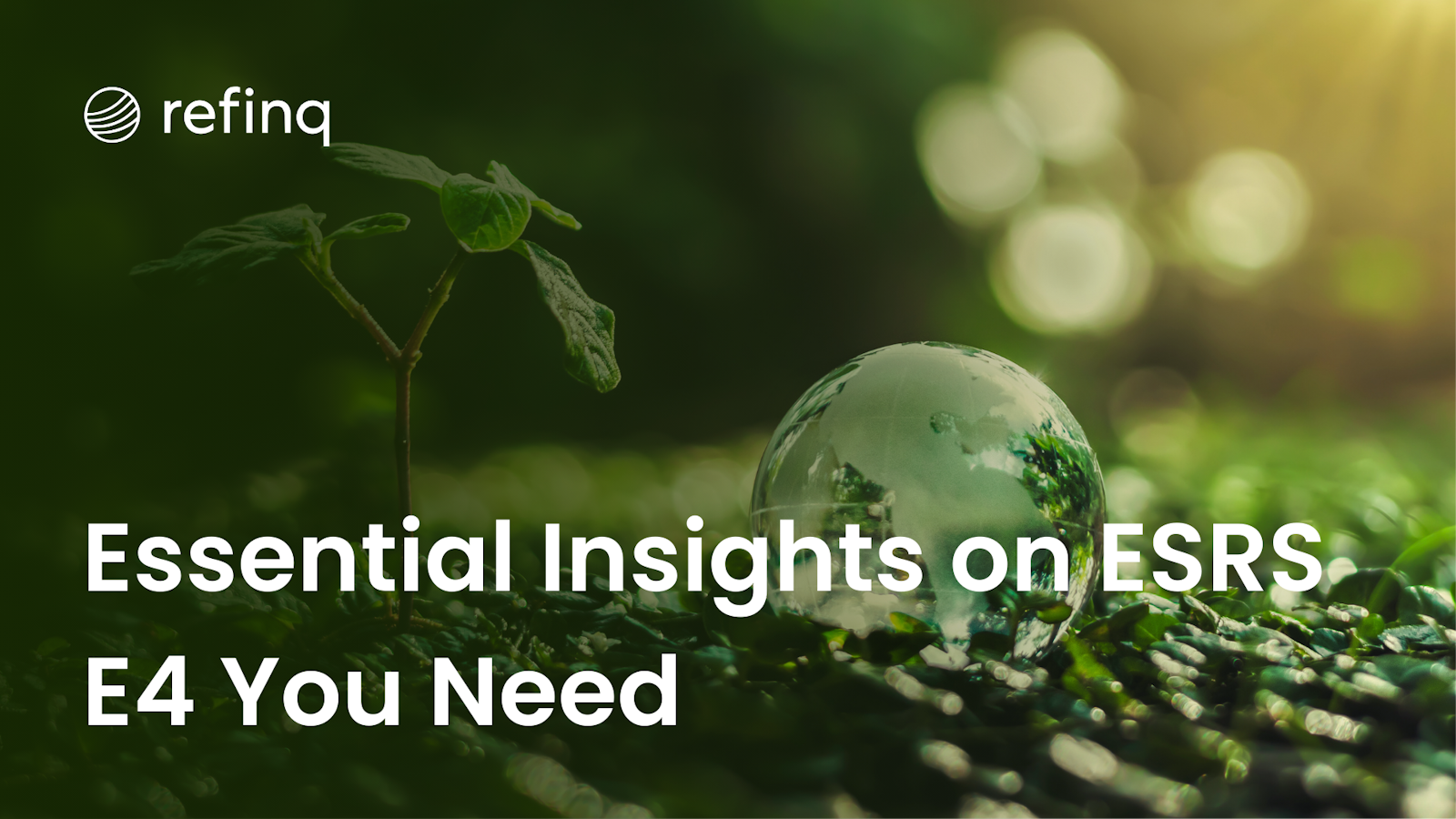

The European Sustainability Reporting Standard (ESRS) E4 is a pivotal framework focusing on biodiversity and ecosystems. It outlines reporting requirements for companies to disclose their environmental impacts, risks, and opportunities, aligning with global sustainability efforts. As biodiversity loss continues to threaten ecosystems and businesses alike, ESRS E4 enables companies to prioritize nature-positive strategies. (Access the full ESRS E4 draft). Platforms like refinq integrate ESRS-aligned tools to help companies address these biodiversity challenges effectively. (Explore how refinq aids ESRS compliance).
ESRS E4 is part of the broader European Sustainability Reporting Standards under the Corporate Sustainability Reporting Directive (CSRD). Specifically addressing biodiversity and ecosystems, it mandates companies to report on:
Environmental Impact
Assessments of operations on biodiversity and ecosystems.
Metrics like habitat quality, species diversity, and land use.
(Learn more about biodiversity metrics).
Risks and Dependencies
Identification of business dependencies on ecosystem services like pollination or water purification.
Analysis of risks stemming from biodiversity loss.
Opportunities for Improvement
Strategies to mitigate biodiversity risks and transition toward nature-positive operations. (Understand biodiversity reporting best practices).
ESRS E4 not only highlights the environmental impacts of business activities but also integrates social considerations:
Environmental Focus: It emphasizes the need to monitor land use, habitat degradation, and species diversity. Companies must disclose measurable data to demonstrate their biodiversity impact mitigation efforts. (Explore biodiversity impact monitoring).
Social Considerations: The standard also recognizes the socio-economic impact of biodiversity loss, urging companies to evaluate their influence on local communities. (Read more about biodiversity’s social impacts).
The ESRS E4 framework is guided by several principles aimed at improving biodiversity management:
Transparency
ESRS E4 aims to make corporate biodiversity impacts more transparent to stakeholders by requiring detailed and measurable disclosures.
Alignment with Global Standards
The framework aligns with international initiatives such as the TNFD and the UN Sustainable Development Goals (SDGs).
Actionable Reporting
ESRS E4 emphasizes not just reporting but actionable strategies to reduce biodiversity impacts and enhance ecosystem restoration. (Discover more about ESRS objectives).
Enhanced Transparency and Accountability
Companies adhering to ESRS E4 demonstrate transparency in their biodiversity-related impacts and efforts. This builds stakeholder trust and aligns businesses with global sustainability goals.
Regulatory Compliance
ESRS E4 is a key component of the CSRD, making compliance essential for companies operating in the European Union. Non-compliance risks legal penalties and reputational damage. (Learn about implementing ESRS under CSRD).
Strategic Risk Management
By identifying dependencies on ecosystem services and biodiversity risks, businesses can safeguard their operations and supply chains. Platforms like refinq offer tools for comprehensive biodiversity assessments to ensure compliance with ESRS E4. (Explore refinq’s biodiversity solutions).
ESRS E4 aligns closely with the CSRD, requiring detailed environmental disclosures from companies. These disclosures focus on measurable biodiversity impacts, aligning with frameworks like the Taskforce on Nature-related Financial Disclosures (TNFD). (Read more about CSRD integration).
refinq simplifies the process of complying with ESRS E4 by providing tools that process over 2.5 billion geospatial data points. These tools enable companies to monitor biodiversity impacts, assess risks, and develop actionable strategies. (Discover refinq’s geospatial capabilities).
With its machine learning and geospatial analysis, refinq translates complex environmental data into meaningful insights. Businesses can prioritize biodiversity risks, generate audit-ready reports, and align their strategies with global standards like ESRS E4 and CSRD. (Learn how refinq drives sustainability efforts).
Challenges
Complex Data Requirements: Collecting and reporting comprehensive biodiversity data can be resource-intensive.
Capacity Building: Many companies may lack expertise in biodiversity monitoring and assessment.
(Learn about practical biodiversity reporting challenges).
Benefits
Enhanced Risk Management: By identifying biodiversity dependencies, companies can mitigate risks to their operations and supply chains.
Reputation Building: Demonstrating biodiversity stewardship improves stakeholder trust and aligns businesses with consumer expectations.
Regulatory Compliance: Adhering to ESRS E4 ensures companies meet legal obligations under the CSRD. (Explore benefits of ESRS E4).
ESRS E4 is a critical framework for biodiversity and ecosystem accountability, urging businesses to enhance transparency and integrate sustainability into their operations. By leveraging tools like refinq, companies can simplify compliance, mitigate risks, and contribute to nature-positive outcomes. Embracing ESRS E4 equips businesses to navigate evolving regulatory landscapes while demonstrating their commitment to sustainability.